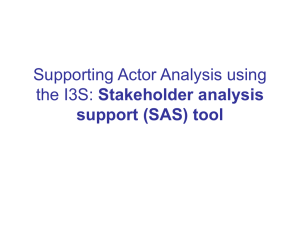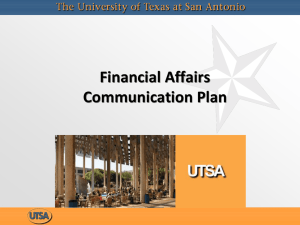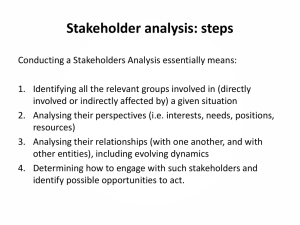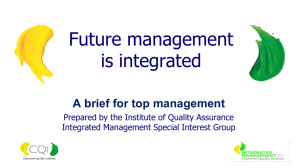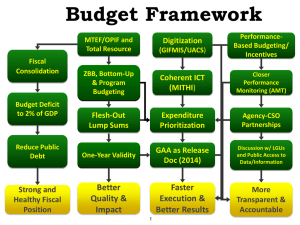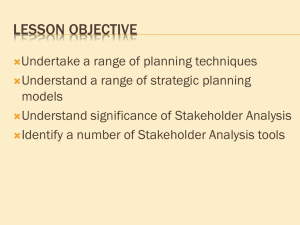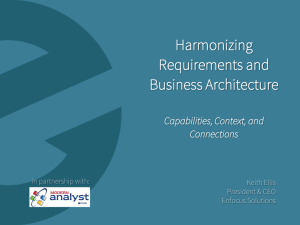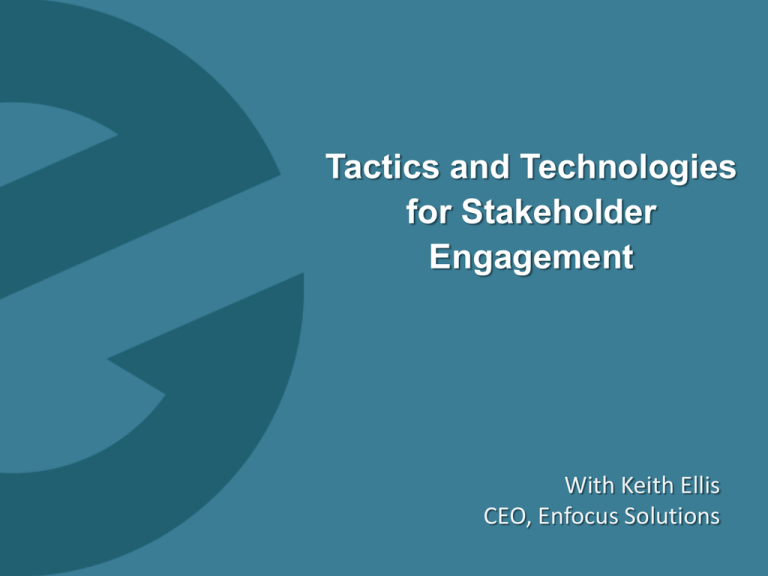
Tactics and Technologies
for Stakeholder
Engagement
With Keith Ellis
CEO, Enfocus Solutions
0
What are we going to talk about?
• Engagement does not happen by chance
• What should you “communicate”?
• What Questions…
What Technologies…
What works…?
1
About Enfocus Solutions
Business Analysis and Requirements Management
2
Learning Objectives
• What tactics can be used to gain
stakeholder interest and open them to
engagement?
• How do you improve the dynamics of
the relationship through enhanced
communication and shared practices
• What key questions are essential for
the analyst to ask?
In PMBOK
5.1
5.2
5.5
10.3
10.4
Collect requirements
Define Scope
Control Scope
Distribute Information
Manage Stakeholder
Expectations
• What technologies can be used to
support stakeholder collaboration
3
QUESTION:
What is the difference between
Stakeholder Communication and
Stakeholder Engagement
4
Communication versus Stakeholder Engagement
Stakeholder engagement is:
Planned
Measured
Enabled
5
Stakeholders want (golden rules):
• A say in decisions that could affect their lives.
• A promise that the stakeholder’s contribution will
influence the decision.
• Seek out and facilitate the involvement of those
potentially affected.
• Input on how they participate.
• Information they need to participate in a meaningful way.
• Communicate how their input affected the decision.
Adapted from Core Values for the Practice of Public Participation by
the International Association for Public Participation
6
Stakeholder Engagement Tactics:
•
•
•
For Planning
For Measuring Engagement
For Enabling Engagement
7
Stakeholder Engagement is Planned
• When you think “Stakeholder
Engagement”, most people
think:
o “Getting requirements”
• Plan your cycle of engagement:
o Vision and problem
definition
o Ideation to feature
o Feature to requirements
o Requirements to value
8
Broaden the Perspective on the
Stakeholders to Engage
• There is a tendency to focus on and engage stakeholders that
are already ‘engaged’ or interested:
o Keep Satisfied: Low interest stakeholders with
high organizational power.
o Keep Informed: Higher impacted stakeholders
with lower organizational power.
o Keep Monitoring: General SMEs and contributors,
while always watching for related projects.
9
Stakeholder Engagement is Measured
The level of stakeholder engagement is a tangible thing:
•
•
•
•
•
•
Stakeholder satisfaction (or complaints)
Number of stakeholder comments received
Stakeholder lifecycle participation
Number of participating stakeholders
Stakeholder attendance percentage
Number of needs identified by stakeholders
Some Example Techniques
Retrospectives
Gather
Statistics
Surveys
Task
Participation
Learning
Participation
10
Stakeholder Engagement is Enabled
• Embed training into your plan
• Keep coming back to a “you are here” graphic to
visualize context and focus
• Have stakeholders describe needs or scenarios in
their own words
• Be clear that stakeholders must prioritize…
• Providing tooling for project transparency,
collaboration, and to see how their participation
translated into action
11
Tooling Provides Engagement
Advantages
• Common repository
• Dashboards
• Task lists
• Voting
• Recording needs and
scenarios
12
Improving Relationship Dynamics
13
Practices to Remember
• Stakeholders often have NO context for your content:
o Keep this in mind when communicating – ALWAYS
communicate project and personal context (WIIFM) in
every message
• ‘Engagement’ and ‘pushback’ are often the same thing:
o People that are passively engaged are ‘academically
interested’ in what you say.
o People that are actively engaged are ‘operationalizing’
what you say.
• Make your VALUE in the process clear.
14
How Business Analysts Deliver Value
© Copyright 2013 Enfocus Solutions Inc. All Rights Reserved.
15
What questions are essential for the
analyst to ask?
16
Early in the Project lifecycle
• Look for the governance (compliance, legal, management) or
financial stakeholder involvement:
o When scheduling an appointment in this clinical care system, are there conditions
under which compliance, legal or management need to be informed?
• Look for the ways other staff groups augment a process:
o I see that marketing is involved in setting pricing for promotions, are there other
things that marketing needs to do for sales or operations as it relates to this
catalogue system?
• Look for the power base:
o We’ve seen four types of benefits: reducing staff time, delivering higher data
quality, increasing conversion speed, decreasing conversion cost: Who would own
each of those benefits? Why is that outcome a good thing for them?
17
Mid-cycle:
Prioritization and Quick Wins
• Get people thinking about development as a balance between met and unmet
needs:
o What needs are met by these requirements? What’s unmet… and can we live with that?
• People overlook the simple questions that absolutely make a project:
o What are our quick wins?
• People overlook asking about risk and removing barriers:
o What would prevent us from achieving the business outcome?
• When people ask about prioritization, they often prioritize the wrong thing.
o Prioritize at the feature level, not requirements…
18
Late Stage: Maximize VALUE
(but minimize productivity drop)
• ASK EARLY AND OFTEN: Solution assessment and validation:
o Does the solution address the requirements we defined?
- How am I going to make that decision? Where am I going to have
stakeholders involved?
- Structured walkthrough…
- Evaluate solution against benchmark…
o Is this solution delivering against what was expected.
• Value realization:
o What else can be done to deliver more value to the business
• Setting transition requirement details – get stakeholder input:
o Training, data conversion, user set-up, deployment, production
management, etc.
o How do we minimize distraction to the business in this transition?
19
Technologies for Stakeholder Collaboration
20
Basic Stakeholder Needs
Technology is the enabler… It has to support the
stakeholder engagement process
• Contribute: Make it easy for me to
find information, contribute, and
track change so I’m not intimidated.
• Be Informed: Put all the
information on this project in one
place so I’m encouraged to go there.
• Provide Oversight: Let me do all my
management of this project in one
place: assign tasks, overview/track,
review/approve, comment/
feedback.
The end-to-end
experience in a
technology has to
be solid
21
When you approach technology think through
the end-to-end scenario of what the engaged
stakeholder needs to experience
See only what
relates to me
Jump into an
important feature
I’m tracking
Add a comment or
vote
See delivery status on
something else that’s
important to me
Get on
with my
day…
Get a snapshot of
status
See the
drafted
requirements
Check out a
project impact
to my role
22
Golden rules for stakeholder
collaboration technology
• Stakeholders have NEEDS and they have business
scenarios which exist for their business…
o Stay away from forcing them to define their own
requirements.
• Stakeholders do not like being asked to do highly
complex tasks which have little immediate payback.
o Stay away from forcing them to do their own modelling.
• Stakeholders LIKE to participate… if it’s easy and
productive
o Remember how we defined productive?
23
Stakeholders want (golden rules):
• A say in decisions that could affect their lives.
• A promise that the stakeholder’s contribution will
influence the decision.
• Seek out and facilitate the involvement of those
potentially affected.
• Input on how they participate.
• Information they need to participate in a meaningful way.
• Communicate how their input affected the decision.
Adapted from Core Values for the Practice of Public Participation by the
International Association for Public Participation
24
Learning Objectives
• What tactics can be used to gain
stakeholder interest and open them to
engagement?
In PMBOK
• How do you improve the dynamics of
the relationship through enhanced
communication and shared practices
• What key questions are essential for
the analyst to ask?
5.1
5.2
5.5
10.3
10.4
Collect requirements
Define Scope
Control Scope
Distribute Information
Manage Stakeholder
Expectations
• What technologies can be used to
support stakeholder collaboration
25
Wrap Up and A Word From Our Sponsor
Call for tools for business analysis and
requirements management, and,
the RequirementCoach community
www.enfocussolutions.com
26
Reaching Keith:
Discussion
877-253-0275 (x120)
Andrea Palten
apalten@enfocussolutions.com
27



